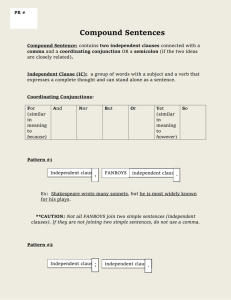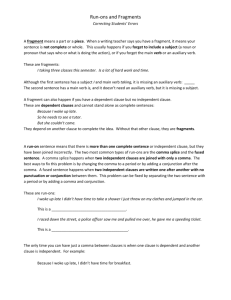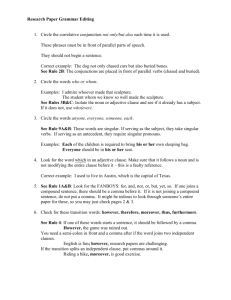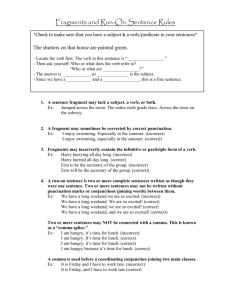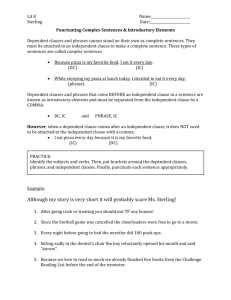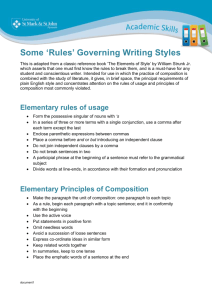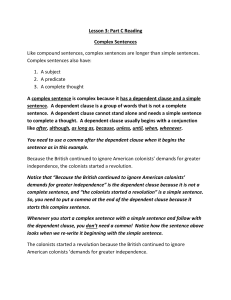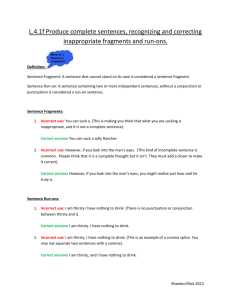Recognizing and Correcting RUn
advertisement
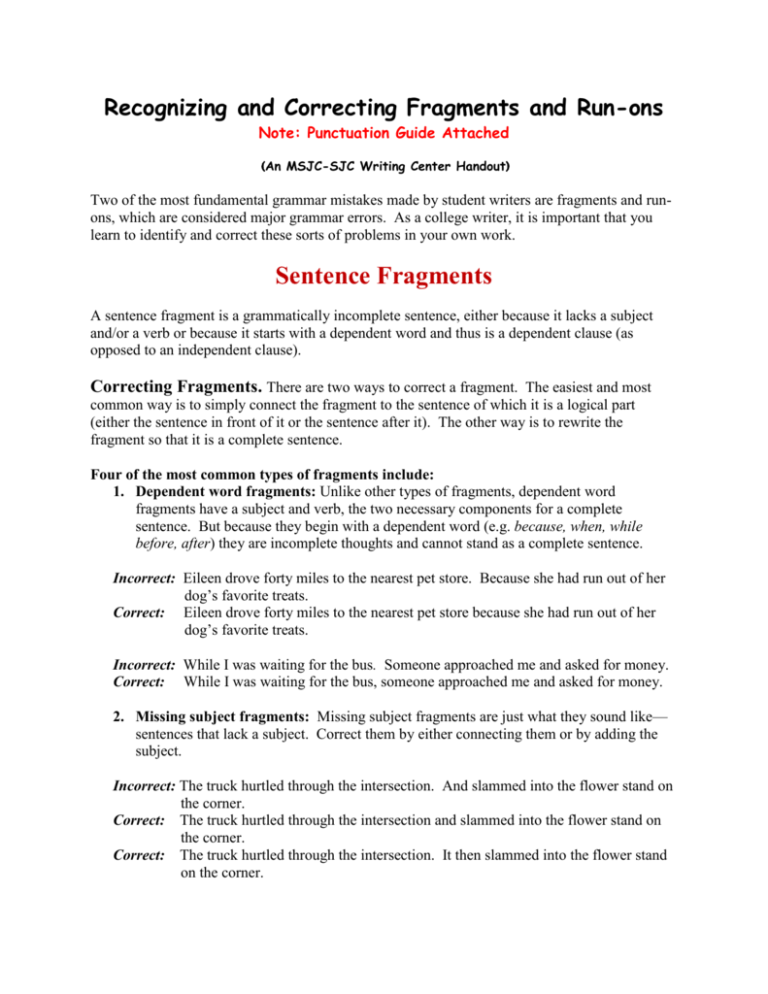
Recognizing and Correcting Fragments and Run-ons Note: Punctuation Guide Attached (An MSJC-SJC Writing Center Handout) Two of the most fundamental grammar mistakes made by student writers are fragments and runons, which are considered major grammar errors. As a college writer, it is important that you learn to identify and correct these sorts of problems in your own work. Sentence Fragments A sentence fragment is a grammatically incomplete sentence, either because it lacks a subject and/or a verb or because it starts with a dependent word and thus is a dependent clause (as opposed to an independent clause). Correcting Fragments. There are two ways to correct a fragment. The easiest and most common way is to simply connect the fragment to the sentence of which it is a logical part (either the sentence in front of it or the sentence after it). The other way is to rewrite the fragment so that it is a complete sentence. Four of the most common types of fragments include: 1. Dependent word fragments: Unlike other types of fragments, dependent word fragments have a subject and verb, the two necessary components for a complete sentence. But because they begin with a dependent word (e.g. because, when, while before, after) they are incomplete thoughts and cannot stand as a complete sentence. Incorrect: Eileen drove forty miles to the nearest pet store. Because she had run out of her dog’s favorite treats. Correct: Eileen drove forty miles to the nearest pet store because she had run out of her dog’s favorite treats. Incorrect: While I was waiting for the bus. Someone approached me and asked for money. Correct: While I was waiting for the bus, someone approached me and asked for money. 2. Missing subject fragments: Missing subject fragments are just what they sound like— sentences that lack a subject. Correct them by either connecting them or by adding the subject. Incorrect: The truck hurtled through the intersection. And slammed into the flower stand on the corner. Correct: The truck hurtled through the intersection and slammed into the flower stand on the corner. Correct: The truck hurtled through the intersection. It then slammed into the flower stand on the corner. 3. “ing” and “to” fragments: Two more common fragment types begin with either a gerund (the “ing” form of a verb, i.e. trying) or an infinitive (the “to” form of a verb, i.e. to try). Incorrect: Julie spent almost four hours on the Internet. Trying to find a new job. Correct: Julie spent almost four hours on the Internet trying to find a new job. Incorrect: Nelson waited patiently for the red light to turn green. Not realizing that the signal light was not working. Correct: Nelson waited patiently for the red light to turn green, not realizing that the signal light was not working. Incorrect: Alfonso worked until midnight. To get his paper finished on time. Correct: Alfonso worked until midnight to get his paper finished on time. 4. Added detail fragments: Added detail fragments are one of the most common types of fragments and are usually preceded by phrases such as for example, such as, and including. Incorrect: I enjoy outdoor activities. Such as hiking, cycling, and rock-climbing. Correct: I enjoy outdoor activities such as hiking, cycling, and rock-climbing. Incorrect: Tom enjoys several science fiction television shows. For example, Star Trek, Stargate, and Battlestar Galactica. Correct: Tom enjoys several science fiction televison shows. For example, he regularly watches Star Trek, Stargate, and Battlestar Galactica. Note: When introducing a list with a phrase like “such as” or “for example,” do not use a colon with the phrase. You can use a colon to introduce a list, but if you do, the word group before the colon must be a complete thought (an independent clause). Incorrect: Helena likes loud, primary colors such as: red, blue, and yellow. Correct: Helena likes loud, primary colors such as red, blue, and yellow. Correct: Helena likes loud, primary colors: red, blue, and yellow. Run-on Sentences Run-on sentences are two or more sentences run together without the proper punctuation between them. Run-ons come in two types: fused sentences and comma splices. (Note: some texts and teachers do not consider comma splices to be true run-ons, but most do.) 1.) Fused sentences: Fused sentences are two or more sentences that are “fused” together rather than being separated with the proper punctuation. Incorrect: Tony is in love with Lola he thinks she is beautiful. Correct: Tony is in love with Lola. He thinks she is beautiful. 2.) Comma Splices: A comma splice occurs when a writer “splices” two sentences together by using a comma alone between them. Incorrect: Tony is in love with Lola, he thinks she is beautiful. Correct: Tony is in love with Lola, and he thinks she is beautiful. Correcting Run-ons. There are essentially five methods to correct run-on sentences, and while more than one technique may work to correct any given run-on, one method might be preferable to another depending on the specific situation. 1. Use a period (and capitalize as necessary). 2. Use a comma with a connecting word. 3. Use a semicolon alone. 4. Use a semicolon with a conjunctive adverb. 5. Use subordination. 1. Using a period: Using a period is perhaps the easiest and most fundamental way to fix a run-on, but if you choose this technique, don’t forget to capitalize as necessary. Incorrect: Felix is interested in astronomy, he is fascinated by the heavens. Correct: Felix is interested in astronomy. He is fascinated by the heavens. 2. Using a comma with a coordinating conjunction (one of the FANBOYS). If you use a comma to fix a fused sentence, or if you are correcting a comma splice, you must also use a coordinating conjunction, i.e. the FANBOYS: for, and, nor, but, or, yet, so. Incorrect: Tom drove to the store, he was out of milk and eggs. Correct: Tom drove to the store, for he was out of milk and eggs. Incorrect: Tina is often late for work, she usually leaves early, too. Correct: Tina is often late for work, and she leaves early, too. 3. Using a semicolon alone. The semicolon can be used to connect two sentences rather than using a comma and a FANBOYS, but its use is not arbitrary. Semicolons are used to connect two sentences that are closely related in content. Incorrect: My mother likes musicals, my father prefers action films. Correct: My mother likes musicals; my father prefers action films. Incorrect: Jupiter is the largest planet in the solar system, Mercury is the smallest. Correct: Jupiter is the largest planet in the solar system; Mercury is the smallest. 4. Using a semicolon with a conjunctive adverb. If you connect two sentences using a conjunctive adverb such as however, nevertheless, and in addition (see attached list), use a semicolon before the conjunctive adverb and a comma after it. Incorrect: Alfonso insisted that the work be done by midnight, he refused to pay overtime, though. Correct: Alfonso insisted that the work be done by midnight; however, he refused to pay overtime. Incorrect: Don works two jobs every week he also goes to school part-time. Correct: Don works two jobs every week; in addition, he goes to school part-time. 5A. Using subordination. Run-on sentences can also be corrected by using subordination, turning one of the independent clauses into a dependent clause, often by using a dependent word such as after, because, and when (see attached list). If the dependent clause comes at the start of the sentence, follow it with a comma. If it comes at the end of the sentence, do not use a comma. Incorrect: Pilar enrolled in a French class, she was hoping to take a trip to Paris. Correct: Pilar enrolled in a French class because she was hoping to take a trip to Paris. Incorrect: Hans saw a TV show about shark attacks, after that he refused to swim in the ocean. Correct: After he saw a show about shark attacks, Hans refused to swim in the ocean. Incorrect: The front door banged loudly in the wind, Dorothy almost jumped out of her skin. Correct: When the front door banged loudly in the wind, Dorothy almost jumped out of her skin. 5B. Subordination can take other forms as well, including using a gerund (the “ing” form of a verb) or a relative pronoun (such as who or which). Also note that a dependent word group can interrupt an independent clause rather than preceding it or following it. Incorrect: Dave decided to invest his inheritance, this proved to be a smart move. Correct: Dave decided to invest his inheritance, which proved to be a smart move. Incorrect: Mons Olympus is the tallest mountain on Mars, it is fifteen miles high. Correct: Mons Olympus is the tallest mountain on Mars, rising fifteen miles into the air. Incorrect: Edwin Hubble is a famous twentieth century astronomer he discovered that the universe is expanding. Correct: Edwin Hubble, a famous twentieth century astronomer, discovered that the universe is expanding. The chart on the next two pages is a must-have. Make a copy and keep it with your writing materials!! A Chart of Methods for Correcting Run-On Sentences (An MSJC-SJC Writing Center Handout) Method 1 Create two sentences. Independent clause . Capital letter Independent clause Coordination Method 2 Use a comma and a coordinate conjunction Independent clause , for , and , nor , but , or , yet , so Independent clause Method 3 Use a semicolon Independent clause Method 4 Use a semicolon and a conjunctive adverb Independent clause ; ; also, ; as a result, ; besides, ; certainly, ; consequently, ; finally, ; furthermore, ; however, ; incidentally, ; in addition, ; in fact, ; instead, ; likewise, ; meanwhile, ; moreover, ; nevertheless, ; next ; on the other hand, ; otherwise, ; similarly, ; still ; then ; therefore, ; thus ; undoubtedly, Subordination Independent clause Independent clause (Conjunctive adverbs that are only one syllable do not need a comma.) after although as as if because before even though if in order that since so that though unless Method 5 Independent clause Dependent clause (No comma is needed when a dependent clause “trails” the independent clause.) when whenever where whereas whether while After Although As As if Because Before Even though If In order that Since So that Though Unless Until Method 6 Dependent clause Independent clause (When a dependent clause introduces an independent clause, put a comma after it.) When Whenever Where Whereas Whether While We sincerely thank and acknowledge contributions by the following: Hacker, Diane. The Bedford Handbook. 7th ed. Boston: Bedford/St. Martin’s, 2006. Langan, John. English Skills. 8th ed. New York: McGraw Hill, 2007. This handout made available by Writing Center staff for the Mt. San Jacinto College San Jacinto Campus Writing Center. 2009.
